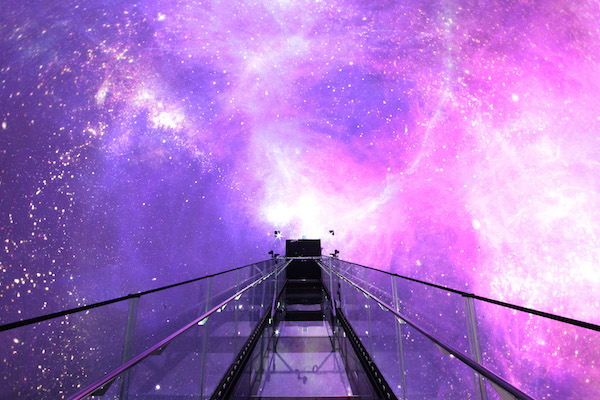
DATAPATH PROCESSORS POWER SPHERICAL THEATRE IN SOUTH KOREA

This spherical projection theatre – 12m in diameter – can be considered a true VR theatre of the future. When visitors step inside, they find themselves on a transparent glass observation bridge, which crosses the sphere’s interior. A crisp 360 video projection around, above, and below the viewers fully immerses them as they stand and watch.
The Concept
Full spherical projection theatres can be considered movie theatres of the future. However, most of them are experimental one-of-a-kind installations utilising technologies that are already outdated.
The aim of specialist AV integrator Front Pictures was to create a projection sphere of the next generation by accumulating the world’s best practices and implementing the newest technologies. To be sustainable the future, the system also needed to have the highest possible resolution and brightness of projection, high energy efficiency and cost effectiveness.
Engineering Challenges
Front Pictures has vast experience in engineering fulldome theatres and planetariums. By the mid 2017, the company has delivered around 150 fulldome systems to many countries around the world. But when designing the projection system for Space 360, the company’s team had to come up with unique technological and engineering solutions.
Unlike in a conventional digital planetarium, where projectors are located along the dome’s perimeter, the options for placing thеm in a full sphere are substantially limited. One of the challenges was to devise a layout that would avoid shadows being cast by the observation bridge, minimise openings for the projectors, while, at the same time, maximising the resolution and brightness of the projection. It was also important to position the projectors in a way that would prevent them from shining light into the viewers’ eyes.

Taking all the factors into account, Front Pictures team decided to use 12 projectors and locate them around two entrance doors.
Datapath’s engineers devised a dozen types of projection layouts, considering models from four different vendors.
Front Pictures used precise 3D models of the venue and calculated each projector position and tilt taking into account its aspect ratio, resolution, and available lenses. The projector size was taken into consideration as well, because of the limited space behind the spherical screen where the projectors had to be located. Price constraints were also important for meeting the budget. After doing research, Front Pictures opted to use Barco PGWU-62L WUXGA projectors with a laser phosphor light source.

Image Calibration
The spherical screen creates significant geometrical distortions of the projected image.
The distortions become even larger due to the fact that in a full projection sphere, it is impossible to place projectors along the perimeter, as a sphere has no edge. They need to be located around the entrance doors on the opposite sides of the sphere.
This scheme has many advantages, but positioned this way, projectors create uneven and elongated spots of light with uneven pixel density and brightness. The task of creating a seamless picture with uniform brightness becomes even more challenging when the projected images overlap with each other in this way.
With a trio of Datapath Fx4 splitting the single GPU input into 12WUXGA outputs, the project not only delivered stunning picture quality, but by using this unique approach also proved highly cost effective.
Datapath: www.datapath.co.uk
Australian Distributor: www.midwich.com.au















RESPONSES